
The Topics | Home
16
ANALYTIC TRIGONOMETRY
THE UNIT CIRCLE
The definitions
The signs in each quadrant
Quadrantal angles
The unit circle
ANALYTIC TRIGONOMETRY takes place on the x-y plane.
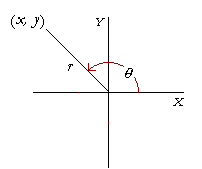
Let a straight line of length r sweep out an angle θ in standard position, and let the coördinates of its extremity be (x, y). The question is: How shall we now define the six trigonometric functions of θ?
We will take our cue from the first quadrant. In that quadrant, a
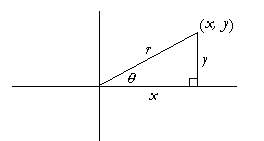
radius r will terminate at a point (x, y). Those coördinates define a right triangle. The original definitions (Topic 4) of the six trigonometric functions follow.
| sin θ |
= |
y
r |
|
csc θ |
= |
r
y |
| |
| cos θ |
= |
x
r |
|
sec θ |
= |
r
x |
| |
| tan θ |
= |
y
x |
|
cot θ |
= |
x
y |
where, according to the Pythagorean theorem,

This is the analytic definition for an angle terminating in any quadrant. It is in terms of the coördinates (x, y) of the endpoint of a radius r.
But before we give an example, consider this question:

Will a function of θ depend of the length of r?
To see the answer, pass your mouse over the colored area.
To cover the answer again, click "Refresh" ("Reload").
Answer the question yourself first!
No, it will not. The functions are in terms of the ratios of the sides, not their lengths.
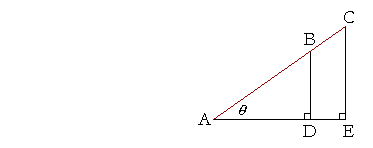
Say that AB, AC are two different radii. But triangles ABD, ACE are similar. (Theorem 15) Proportionally,
DB : BA = EC : CA
sin θ -- opposite over hypotenuse -- does not depend of the length of the radius. And similarly for the remaining functions. Therefore, we may choose any radius we please. Typically, we take r = 1. That is called the unit circle, as we will see.
Example 1. A straight line inserted at the origin terminates at the point (3, 2) as it sweeps out an angle θ in standard position. Evaluate all six functions of θ.
Answer. x = 3, y = 2. Therefore, according to the definitions:

| sin θ |
= |
y
r |
= |
2
 |
|
csc θ |
= |
r
y |
= |

2 |
| |
| cos θ |
= |
x
r |
= |
3
 |
|
sec θ |
= |
r
x |
= |

3 |
| |
| tan θ |
= |
y
x |
= |
2
3 |
|
cot θ |
= |
x
y |
= |
3
2 |
Problem 1. A straight line from the origin sweeps out an angle θ, and it terminates at the point (3, −4). Evaluate the six functions of θ.
x = 3, y = −4. Therefore,

| sin θ |
= − |
4
5 |
|
csc θ |
= − |
5
4 |
| |
| cos θ |
= |
3
5 |
|
sec θ |
= |
5
3 |
| |
| tan θ |
= − |
4
3 |
|
cot θ |
= − |
3
4 |
Problem 2. The signs in each quadrant.

a) The algebraic sign of sin θ will always be the sign of which
a) coördinate? y, because r is always positive.
a) Therefore, in which quadrants will sin θ -- y -- be positive? I and II.
a) In which quadrants will sin θ be negative? III and IV.
b) The algebraic sign of cos θ will always be the sign of which
b) coördinate? x, because r is always positive.
a) Therefore, in which quadrants will cos θ -- x -- be positive? I and IV.
a) In which quadrants will cos θ be negative? II and III.
c) In which quadrants will the algebraic sign of tan θ (y/x) be positive?
I and III. x and y will have the same signs.
d) In which quadrants will the algebraic sign of tan θ be negative?
II and IV. x and y will have opposite signs.
e) csc θ will have the same sign as which other function?
sin θ, because they are reciprocals.
f) sec θ will have the same sign as which other function?
cos θ
g) cot θ will have the same sign as which other function?
tan θ
Problem 3. A straight line makes an angle θ with the x-axis. The value
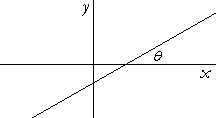
of which function of θ is equal to its slope?

Quadrantal angles
A quadrantal angle is an angle that terminates on the x- or y-axis.
Problem 4.
a) What are the quadrantal angles in degrees?
0°, 90°, 180°, 270°; and angles coterminal with them.
b) What are the quadrantal angles in radians?
| 0, |
π
2 |
, π, |
3π
2 |
; and angles coterminal with them. |
c) When an angle terminates on the x-axis, what is the value of the
c) y-coördinate? 0. On the x-axis, y = 0.
d) When an angle terminates on the y-axis, what is the value of the
c) x-coördinate? 0. On the y-axis, x = 0.
Now, it is a fact of arithmetic that there is no number with denominator 0.
Therefore, wherever a trigonometric function has a denominator -- x or y -- equal to 0, the function will not exist at that quadrantal angle.
For example,
Wherever x = 0, tan θ will not exist. Where does x = 0? When the angle terminates on the y-axis.
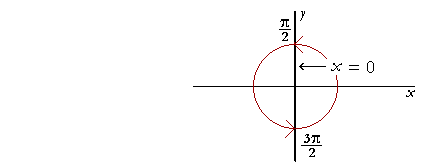
| tan θ will not exist at θ = |
π
2 |
and θ = |
3π
2 |
. |
Problem 5. For which quadrantal angles do the following functions not exist?
|
a) cot θ |
|
cot θ = |
x
y |
. Therefore, whenever y = 0 -- that is, on |
the x-axis -- cot θ will not exist. cot θ will not exist at θ = 0 and θ = π.
b) sec θ
| sec θ = |
r
x |
. Therefore, sec θ will not exist where x = 0, |
| which is on the y-axis. sec θ will not exist at θ = |
π
2 |
c) sin θ
| sin θ = |
y
r |
. But r is never 0. There is no angle for which |
sin θ does not exist.
The unit circle
Let us now consider a circle of radius 1, the unit circle. On the unit

circle the functions take a particularly simple form. For example,
The value of sin θ is the y-coördinate of the unit radius! The value of cos θ is the x-coördinate!
The unit circle illustrates the following point:
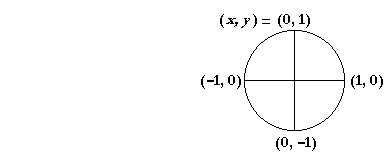
If a function exists at a quadrantal angle,
it could have only the values 0, 1, or −1.
Consider sin θ at each quadrantal angle. We just saw that the value of sin θ is the y-coördinate of the unit radius:
sin θ = y.
Therefore at each quadrantal angle, the value of sin θ -- of y -- is either 0, 1, or −1.
| At θ = 0, |
sin θ = 0. |
| |
| At θ =
| π
2 |
, sin θ = 1. |
| |
| At θ = π, |
sin θ = 0. |
| |
| At θ =
| 3π
2 |
, sin θ = −1. |
To evaluate a function at a quadrantal angle, the student should sketch a unit circle.
Problem 6. Evaluate the following. No tables!
a) cos 0°
cos 0° = 1. cos θ is equal to the x-coördinate.
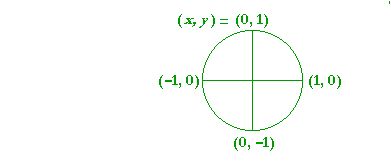
b) cos 90°
= 0
c) cos 180°
= −1
d) cos 270°
= 0
e) tan 0°
tan 0° = 0. tan θ is equal to y/x = 0/1 = 0.
f) tan 90°
1/0 does not exist.
g) tan 180°
= 0
h) tan 270°
does not exist.
Problem 7. Evaluate the following -- if it exists. No tables.
|
b) sin |
π
2 |
|
= 1 |
|
c) sin |
π |
|
= 0 |
|
d) cos |
π |
|
= −1 |
|
e) cot 0 |
|
= x/y. Does not exist. |
|
f) cot |
π
2 |
= 0 |
|
|
g) tan |
π
2 |
Does not exist. |
h) sec 0 |
|
= 1/x = 1 |
i) csc (− |
π
2 |
) |
= −1 |
|
j) sin 2π |
= 0 |
k) sin 3π |
= 0 |
l) sin 4π |
= 0 |
m) sin (−π) |
= 0 |
|
n) cos 2π |
= 1 |
o) cos 3π |
= −1 |
p) cos 4π |
= 1 |
q) cos 5π |
= −1 |
Problem 8. Explain why we can write the following, where n could be any integer:
cos nπ = (−1)n
(−1)n = ±1, according as n is even or odd. If n is even (or 0), then cos nπ is coterminal with 0 radians, and (−1)n = 1. See the unit circle. While if n is odd, then cos nπ is coterminal with π radians, and (−1)n = −1.
Next Topic: Trigonometric Functions of Any Angle
The Topics | Home
www.proyectosalonhogar.com
|